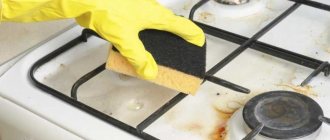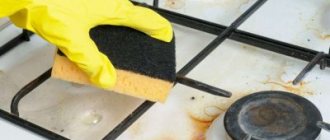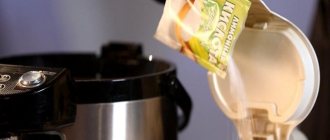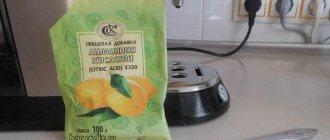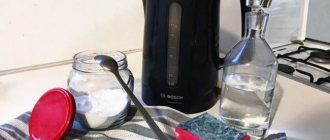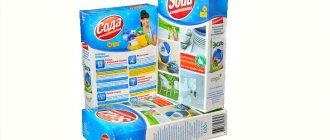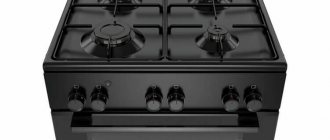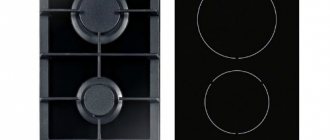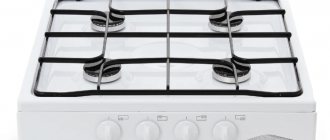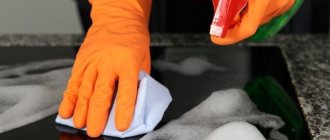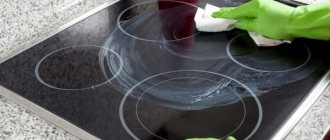Induction cookers look elegant in modern kitchen interiors. They do not take up much space, serve for a long time and without interruption, and do not require complex maintenance. But this does not mean that you can use any cleaning products or metal sponges on these surfaces. To keep glass-ceramic tiles safe and sound, it is important to follow the recommendations.
Rules of service
Induction panels quickly gained popularity among users not so much due to the properties of heat transfer without heating a larger surface area, but due to their stylish and laconic design.
Such hobs provide a smooth (and even mirror-like) surface. The material from which the boards are made can withstand impacts and high temperatures, but it is very easy to scratch (even accidentally). If a knife or fork falls on the stove, it will leave a mark on the surface. This must be taken into account when maintaining the unit.
WE RECOMMEND! Read on our website detailed instructions on how to clean the inside of the refrigerator after defrosting.
In order for glass-ceramic tiles to last for many years, you need to follow some recommendations:
- Wash the stove after it has cooled completely. Otherwise, in 100% of 100 cases, soap stains, remains of burnt food, drops and other dirt will remain on the stove. You can also easily get burned on such a surface.
- It's best to wipe down your stove before you start cooking. This may sound strange to some, since the surface is already clean. But there are already small stains on the tile, they will begin to burn and stick during work, and from small such stains will quickly turn into noticeable and difficult to remove.
- Carefully ensure the cleanliness and smoothness of the bottom of the dishes that you place on the tile. Rough, oily, uneven bottom may damage the surface.
- Make sure that there are no water droplets or streaks left on the stove after cleaning. Be sure to wipe the surface after washing with a paper towel or dry soft cloth.
- You should not use the same sponges or rags to clean your induction cooker that you, for example, use to wash dishes, wipe furniture or windows. Cleaning with such rags will leave stains and streaks.
Daily care
To ensure that your induction hob lasts longer and its appearance remains presentable, clean the surface daily.
IMPORTANT! Daily care includes normal damp cleaning with a suitable mild detergent and a clean sponge without any abrasives. After cleaning, wipe the surface dry with a cloth or paper towel.
Do you have an induction cooker?
Not really
Step by step cleaning:
- Wait for the hob to cool completely.
- Dampen a soft and clean (!) sponge in a soapy solution and wipe the surface of the tile.
- Leave the product on for a few minutes so that it has time to eat away any burnt-on food debris.
- Wipe the surface with a clean, damp cloth to remove any remaining soap, grease or scale.
- Dry with a paper or cloth towel.
Major cleaning
If you just can’t get rid of old stains on your induction hob, then regular wet cleaning will no longer work for you. Here you need to approach the problem radically. For major cleaning you will need rubber scrapers and specialized cleaning products for glass-ceramic surfaces (stoves) :
- Apply your regular detergent to the entire tile surface. Place a cloth soaked in detergent on especially problem areas. Leave everything for a few minutes.
- Wipe with a damp, clean cloth, and remove any remaining burnt food with a rubber scraper. At the same time, hold the spatula at an angle of 30-45 degrees so as not to scratch the panel.
- If the detergent cannot cope with the stains, then it’s time to move on to using specialized preparations that are designed for cleaning induction hobs. Typically, the instructions call for applying a small amount of the product to stains and carbon deposits for a few minutes, after which you need to remove the remaining solution and loose grease with a damp sponge or cloth.
ATTENTION! You can use specialized cleaning products for hobs only with gloves, as they contain aggressive chemical compounds that can corrode the skin.
Clean glass ceramics from carbon deposits
During cooking, various fat formations remain on the surface of the glass-ceramic stove. The following recommendations will help you get rid of old fat and carbon deposits at home:
- Regular warm water will help remove minor formations on the panel. Spray it in the dirty area and then remove the deposits with a sponge;
- In the case of a medium degree of fat deposits, apply a special cream or a gentle household solution to the surface. After some time, it is wiped off with a rag;
- Old carbon deposits from a glass stove are removed using a product containing alkali. It is applied to the contaminated area and after 30 minutes it is removed with a soft material;
In addition, available household products help remove carbon deposits from glass ceramics.
For example, vinegar is an ideal and safe option for cleaning a glass ceramic hob.
Vinegar has a disinfecting effect and removes any bacteria and microorganisms from the surface.
Preparing a vinegar-based cleanser involves the following steps:
- The first step is to mix equal parts vinegar and water;
- The second step is to pour the solution into a spray bottle;
- The third step is to spray in the area of contamination and wait a few minutes;
- Then wipe the stove with a dry cloth.
After these activities, the stove will shine like new.
Information. Regular baking soda also helps housewives fight carbon deposits on the stove.
The product is mixed with water to a paste-like state and distributed over the contaminated area. The paste is left for a few minutes and then removed with a sponge and wiped with a dry cloth. If necessary, the procedure is repeated several times. This is interesting: How to dye jeans at home
Glass from burnt milk
Not only grease stains can remain on the surface of a glass stove. Often the stove has to be cleaned of burnt milk. Regular oil will help remove organic contamination from the surface.
Wait until the contaminated area has cooled down before starting work.
Otherwise, you may get burned and damage the material.
It is recommended to use olive oil to clean glass ceramics.
The product must be applied to a rag or piece of cotton wool and left on the contaminated area for 20-30 minutes.
After this, you can remove the milk stain with a sponge. The oil acts as a softener and helps quickly remove organic stains. After this, the slab is polished with window cleaner.
Important! It is worth noting that vegetable oil acts as a protective agent. Apply a thin layer of oil to the surface and rub. As a result, the slab is covered with a protective film, which allows you to quickly remove any stains.
The ideal product for cleaning glass-ceramic hobs is ammonia. The solution can remove any stubborn stains and deposits, and also polish the slab well. To prepare the solution, mix ammonia with 250 ml of water. After this, distribute the product in the area of contamination for 10 minutes. Then wipe the area thoroughly with a dry cloth.
In the area of the burners, it is recommended to remove stains from burnt milk using a soft sponge with the addition of a soap solution. In addition, a ceramic cleaner, but without abrasive particles in the composition, will help cope with organic contamination.
What rag to wash with
Only soft sponges or cloths without rough surfaces or texture can be used on induction hobs. You should not use metal sponges or scrapers, they will leave scratches on the surface and you will damage the hob. If you don’t have enough sponge to remove heavy carbon deposits, then use a rubber scraper (and then be careful).
What to do is strictly prohibited
Careless handling of the device may lead to damage. When operating and cleaning, you need to be as careful as possible and avoid the following actions:
- Do not clean the cooking surface with preparations containing abrasives. They will leave scratches that will significantly impair the performance of the tile in the future. The same applies to metal sponges, scrapers, knives and other sharp objects.
- Do not rub the surface if there are any hard particles left on it, for example, salt, sugar, etc. First, gently brush everything off or soak up any solid particles, only then proceed with the rest of the cleaning steps.
- Do not start cooking on the stove until you have removed any remaining food from it. Once the panel heats up, any residue will burn. It is very difficult to clean them when they are burnt.
- Do not expose the panel to sudden temperature changes. For example, you should not place objects from the refrigerator on it, splash ice water on it, scatter ice, etc.
How to clean various stains
IMPORTANT! In order for cleaning the hob to be as effective as possible, you need to take into account the type of contamination and its origin. Based on this data, we select a method for removing dirt.
From carbon deposits
Quite often, drops and pieces of food that are not wiped off the surface of the tile in a timely manner turn into soot. If you have started the problem, then you will no longer be able to do without a rubber scraper. You will have to soak the burnt residue for 10-40 minutes in detergent (or in a specialized cream for induction cookers), and then, after the carbon deposits have softened and come off a little, just carefully clean them with a scraper. At the end of the work, be sure to remove any remaining cleaning products and dirt with a damp sponge and wipe everything dry with a paper towel.
Read more about how to clean a ceramic hob from carbon deposits at home.
IMPORTANT! When using a rubber squeegee, always wet the surface before you begin scrubbing to avoid cracking or scratching the surface.
Fat
Regular dishwashing detergent is suitable for removing grease from the cooking surface. It dissolves fat perfectly.
However, it is better to entrust such contamination to specialized sprays, gels or cleaning creams for induction cooktops. They work much more efficiently and will not harm the hob.
How to clean the inside of the oven from grease, read this article.
Sugar
Sugar particles from the induction hob must be removed very carefully (this also applies to products that contain it):
- Cool the stove first.
- Use only silicone scrapers to avoid damaging the panel.
These two rules also apply to other low-melting materials such as polyethylene and plastic - they quickly melt on a hot surface, and then bake and stick tightly to it.
To remove sugar, you need to use major cleaning methods: specialized cleaning products, rubber scrapers, dishwashing detergents, etc.
Stains and plaque
Stains remain on the glossy and perfectly smooth surface of the tile. This is fine. But when these stains start and are not removed in time, they turn into a rather thick layer of plaque, which cannot be removed with ordinary wet daily cleaning.
IMPORTANT! Window cleaner is best for removing stains that appear after using tiles. These products contain chemical compounds that do not leave stains or streaks after drying.
Simply spray the surface of the tiles with the solution, then wait a while and wipe dry with a soft, clean cloth or paper towel.
Read here how to clean your kitchen hood from grease.
How to properly clean a glass-ceramic panel
Housewives are wondering: how to wash an induction cooker quickly and efficiently?
Step-by-step instruction.
- Once the oven has cooled, carefully remove any debris with a scraper.
- Wipe up spilled liquid with a regular sponge or napkin.
- Wipe the surface with any soap solution.
- Remove permanently burnt stains with glass ceramic cleaner. Cover the glass with it so that a protective film remains.
The glass ceramic coating must be dry and clean.
The glass ceramic coating must be dry and clean.
See also: Tips for decorating a window in the kitchen
Removing various contaminants
Cleaning stains and deposits will take a few minutes if you know the rules for effective washing.
Cleaning stains and deposits will take a few minutes if you know the rules for effective washing.
See also Gray kitchen in the interior. Comparing the pros and cons
Removing dried sugar
Before washing off caked-on sugar, jam, caramel or sticky sugar syrup, place a wet rag on the problem area. After 15 minutes, remove with a sponge everything that has become soaked. If the contamination becomes stubborn, repeat.
Before washing off caked-on sugar, jam, caramel or sticky sugar syrup, place a wet rag on the problem area.
See alsoPostforming kitchen countertops: what is it, features, pros and cons, useful tips
Burnt food
Soot and burnt residues can be easily washed off with sunflower oil. If the cleaner doesn't do the job, apply vegetable oil to the stain. After 25-30 minutes, remove the dirt using a scraper. Wipe down the panel.
Soot and burnt residues can be easily washed off with sunflower oil.
See alsoEverything you need to know about standard sizes of kitchen furniture: useful recommendations
Fat
The easiest option is to wash off the grease with dishwashing detergent. Did not help? Spray glass cleaner and go over with a melamine sponge. Remove any remaining sponge and wipe the induction assistant clean.
The easiest option is to wash off the grease with dishwashing detergent.
See alsoKitchen design with an area of 5-6 squares
Limescale, stains
Stains disappear with 9% vinegar. Dampen imperfect areas with it and wipe with a damp cloth. Ammonia will also do the job. It must be mixed with water 1:5. Apply to the surface, after 10 minutes wipe with a paper napkin. After vinegar and ammonia, the surface shines.
Stains disappear with 9% vinegar.
Important! Products containing glycerin or silicone will add additional shine to the glass-ceramic panel.
See alsoKitchen interior with a brick wall: basic decorating rules and design ideas
Folk remedies
It seems that there are a lot of popular methods to solve any problem. This also applies to cleaning the induction hob.
Vegetable oil
For cleaning, you can use vegetable oils (sunflower or olive):
- Apply a small amount of oil to a cloth and apply to the stain for 30 minutes.
- Wash the tiles with your regular detergent.
- Remove any remaining cleaning agent with a damp sponge.
- Wipe the panel dry with a paper towel.
How to clean with baking soda
Not the best option for cleaning an induction hob ( soda can leave scratches on the surface ). Use it only if you are absolutely confident in your abilities:
- Apply baking soda to the stained area.
- Cover the stain with a towel soaked in soapy water.
- Leave the baking soda and soap on the stain for 15-30 minutes.
- Carefully remove any remaining detergent with a damp cloth. But under no circumstances rub the surface!
- Wipe dry with a clean towel.
Baking soda is widely used for cleaning household appliances. In this article you can learn simple recipes for cleaning the oven with soda and vinegar.
Additional recommendations
Finally, I would like to give one more important piece of advice on caring for your induction hob: do not neglect daily wet cleaning. This will change the way you care for your hob for the better.
ADVICE! Immediately remove all burnt food particles from the stove, brush off sugar from the surface only after the stove has cooled, remove stains using specialized cleaning products and wipe dry with a clean soft cloth after use.
These recommendations will help you keep your induction hob in its original condition for many years.
We wash away stubborn stains
The main types of contamination on an induction hob:
- scale;
- fat;
- water stains;
- finger marks;
- burnt food (rare).
Usually the stove does not become so dirty that it becomes difficult to clean. Stains can be easily removed with regular dishwashing detergent and a sponge. To avoid streaks, wipe off the moisture with paper towels.
Special means
Special products are available to care for induction panels. Their use provides certain advantages: the composition includes substances that, when applied to glass ceramics, create an invisible film. It protects the stove from dirt and prevents food from sticking.
- Special scraper for glass ceramics (from 250 RUR). Helps quickly and safely remove grease, dried food residues, scale, and plaque. The scraper is used while holding it at an angle of 45 degrees.
- Cleaning product ELECTROLUX, 250 ml (from 180 rub.). It does not leave scratches, while effectively removing burnt food, polishing glass ceramics and covering it with a protective film.
- Cleaner for glass-ceramic surfaces Glutoclean, 750 ml (about 500 rub.). German quality product. It has a spray bottle, making it easy and quick to apply. Gently cleans the surface, removes grease, scale, and carbon deposits.
- Cream for cleaning glass ceramics and microwave ovens Astonish, 235 ml (170 RUR). An economical, thick, concentrated product cleans all types of dirt on induction cookers. Smells pleasant and creates a protective layer on the surface.
- Beckmann for cleaning glass ceramics, 250 ml (300 rub.). Removes stains well thanks to micro polishing balls. Also contains silicone oils, which create a heat-resistant film and make cleaning the hob easier. And jojoba oil gives the stove a beautiful shine.
- Sano Ceramic Stove Tops Cleaner, 300 ml (430 RUR). A creamy cleaner that polishes and perfectly cleans glass ceramics, chrome, nickel and stainless steel. Recognized with the Israel Institute of Standards Platinum Mark award.
- Detergent for stoves, ovens and microwave ovens Ecover Oven & Hob cleaner, 500 ml (650 RUR). Copes with all types of contaminants. It features the most natural composition. The bottle itself is made from recycled plastic, and the product does not contain harsh chemicals or phosphates that pollute groundwater. Does not irritate sensitive skin.
We recommend: How to quickly clean hard-to-reach places on the glass lid of a pot or frying pan?
Folk remedies
Despite the fact that the induction cooker is a modern invention, many housewives use “popular” products to clean it. They are more environmentally friendly, cheaper and also cope quite well with pollution.
What means can you use to clean the stove?
- Vegetable oil for soot. Apply it to the stain and wait 5-10 minutes. Soak a sponge in warm water and remove the softened carbon deposits along with the oil.
- Baking soda. Dilute baking soda with water to a paste consistency. Apply to the problem area (any type of dirt) for 5-10 minutes. Rub the surface with a damp cloth, and then rinse off the remaining soda.
- Ammonia for stains, fingerprints and greasy deposits. This folk remedy will help clean the stove until it shines. To 5 tbsp. add 1 tbsp to spoons of water. a spoonful of ammonia. Pour into a spray bottle. Treat the surface and wipe with a dry cloth.
- Vinegar for disinfection, removal of scale and foreign odors. Mix salt vinegar half and half with water and pour into a container with a spray bottle. Spray onto the stove. After a few minutes, wipe the surface with a paper towel or rag.
